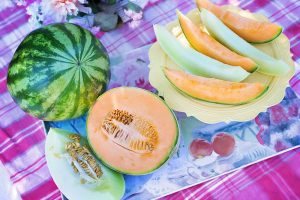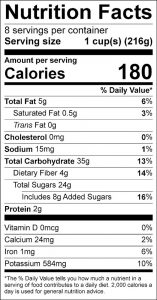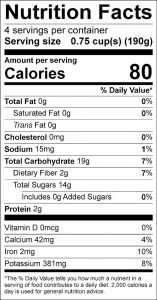Bulletin #4264, Vegetables and Fruits for Health: Melons

Developed by Extension Nutrition Specialist Nellie Hedstrom, University of Maine Cooperative Extension.
For information about UMaine Extension programs and resources, visit extension.umaine.edu.
Find more of our publications and books at extension.umaine.edu/publications/.
Melons come in many varieties, shapes and sizes. They are available all year, but are most abundant during the summer months, May through September. Most melons are sensitive to cold and grow best in a hot, dry climate. A few varieties have been developed to grow in northern regions, including Maine.
Nutrition Information
The nutritive value of melons greatly depends on the variety of melon. Melons are in the same family as squash; their nutritive value ranks somewhere between summer and winter squash. Most are excellent sources of vitamin C and potassium. Varieties with deep orange flesh, such as cantaloupe, are exceptional sources of beta carotene, which provides vitamin A. The vitamin A in one cup of cantaloupe gives one-half of an adult male’s daily Vitamin A requirement and about two-thirds of an adult woman’s. The great thing about melons is that the calorie and fat values are low. Use melons to boost your intake of fruits and vegetables.
Selection
Cantaloupe, honeydew, and watermelon are the best known melons, but also try casaba, crenshaw, or Persian, available in supermarkets and some roadside stands. Some are grown in the United States. Others are imported from Central America and New Zealand.
Melons will not get sweeter after they are harvested. They have no starch reserves to convert to sugar. Melons are best when picked at the peak of ripeness, yet still firm. Select ripe melons. The general rules for selecting a melon are to choose one that is symmetrical in shape; oval, round, or oblong; free of cracks, bruises, or soft spots; and with just a slight softness to the touch. Sweet smell or aroma may or may not be a good clue. Melons that have been chilled will not have much smell. The old test method, “thump and shake,” is not a good indicator of quality.
Storage
Unless you buy melons from a trusted local farmer, you may not know whether the fruit was picked fully ripe with the sugar content at its peak. One way to make the melon juicier is to let it sit at room temperature for two to three days. The sweetness will not improve, but allowing it to sit will soften it and bring it to full juiciness. Then store the melon, cut in pieces, in a plastic bag in the refrigerator. Use it within a couple of days. If the melon is not wrapped in plastic, its odor will be transferred to other refrigerated foods.
Preparation
Serve melon at meals, for snacks, or in bag lunches. Except for watermelon, all melons can be prepared for serving in the same way. Slice the melon open, scoop out the seeds and strings, and slice it for serving. What fruit could you find that is more easily prepared? To remove the rind, slice the melon in sections and slide a sharp knife between the rind and flesh. Cut into serving sizes.
For melon balls, just use a melon scoop. Make an attractive presentation, or eat the melon out-of-hand.
Watermelon has its seeds throughout the flesh, so preparation depends on how you serve it. The seedless variety makes serving easier.
Melon and Banana With Zippy Dressing
Serves 8
4 cups banana, sliced
4 cups cantaloupe, cubed
1 medium avocado, sliced and peeled
Romaine lettuce
1/3 cup sugar
1 tablespoon vegetable oil
1/3 cup lemon juice
1/4 cup water
1 teaspoon celery seeds
1 teaspoon dry mustard
Arrange 1/2 cup sliced banana, 1/2 cup cantaloupe and 1/8 avocado on each of 8 salad plates, lined with lettuce leaves. Place sugar and next 5 ingredients in a small bowl and whisk until well blended. Drizzle 2 tablespoons dressing over each salad.
Melon Compote
4 (3/4-cup servings)
1 1/2 cups cantaloupe, cubed
1 1/2 cups watermelon, cubed
1/2 cup unsweetened apple juice
1 tablespoon mint, finely chopped
1/2 teaspoon orange rind, grated
2 kiwi fruits, peeled and sliced
Combine cantaloupe and watermelon cubes in a medium bowl. Mix apple juice, mint, and orange rind separately. Pour over melon cubes. Toss. Cover and chill 30 minutes. Add kiwi fruit and toss. Garnish with fresh mint leaves, if desired.
Some content adapted with permission from University of Massachusetts Cooperative Extension.
Information in this publication is provided purely for educational purposes. No responsibility is assumed for any problems associated with the use of products or services mentioned. No endorsement of products or companies is intended, nor is criticism of unnamed products or companies implied.
© 1997, 2007
Call 800.287.0274 (in Maine), or 207.581.3188, for information on publications and program offerings from University of Maine Cooperative Extension, or visit extension.umaine.edu.
In complying with the letter and spirit of applicable laws and pursuing its own goals of diversity, the University of Maine System does not discriminate on the grounds of race, color, religion, sex, sexual orientation, transgender status, gender, gender identity or expression, ethnicity, national origin, citizenship status, familial status, ancestry, age, disability physical or mental, genetic information, or veterans or military status in employment, education, and all other programs and activities. The University provides reasonable accommodations to qualified individuals with disabilities upon request. The following person has been designated to handle inquiries regarding non-discrimination policies: Director of Equal Opportunity and Title IX Services, 5713 Chadbourne Hall, Room 412, University of Maine, Orono, ME 04469-5713, 207.581.1226, TTY 711 (Maine Relay System).



